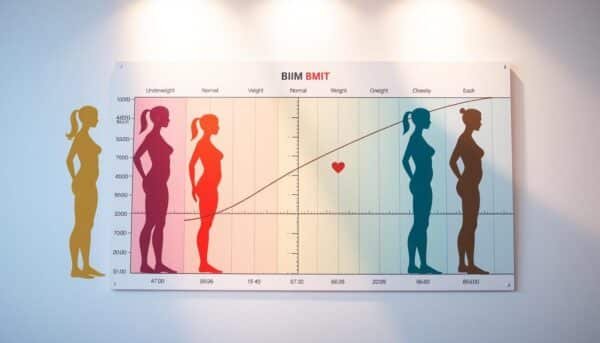As I stood on the scale, my heart sank. The numbers were higher than I had ever seen them before. I knew I had to make a change, but losing 50 pounds in one month seemed daunting. Still, I refused to let my weight define me or hold me back any longer. It was time to take control and embark on a transformative journey.
If you’re like me, you’ve probably tried many diets and exercise plans. But you might feel frustrated and discouraged. But I’m here to tell you that losing weight safely and effectively is possible. This article will guide you through proven strategies, nutritional tips, and workout plans to help you achieve your weight loss goals.
Over the next few sections, we’ll cover 15 ways to lose fat in a month. We’ll talk about calorie counting, avoiding refined carbs, increasing cardio, and proper hydration. By the end, you’ll have the tools and knowledge to start a weight loss journey. This journey will not only deliver results but also set you up for long-term success.
Understanding Weight Gain and Its Health Impacts

Obesity is a common health issue. It happens when you have too much body fat. Knowing why weight gain happens and its health risks is key to staying healthy.
Common Causes of Weight Gain
Several things can lead to weight gain, including:
- Genetics and family history
- Sedentary lifestyle and physical inactivity
- Overeating, especially of high-calorie, high-carbohydrate foods
- Certain medications, such as antipsychotics, antidepressants, and steroids
- Hormonal imbalances, such as in Polycystic Ovary Syndrome (PCOS) or hypothyroidism
- Psychological factors, such as stress, anxiety, and emotional eating
Health Risks Associated with Excess Weight
Being overweight can lead to many health problems, including:
- Type 2 diabetes: Obesity increases the risk of developing diabetes by up to 20 times.
- Heart disease: Overweight individuals face a 32% higher risk of heart disease, while obesity increases the risk by 81%.
- Stroke: Overweight individuals have a 22% higher risk of stroke, which increases to 64% for obese individuals.
- Cancer: Overweight and obesity may account for 14% of all cancer deaths in men and 20% of all cancer deaths in women.
- Musculoskeletal issues: Excess weight can make it harder to perform everyday tasks, such as walking, lifting, and rising from a chair.
The Role of BMI in Weight Assessment
Body Mass Index (BMI) is a common way to check weight status. A BMI of 25 or higher is overweight, and 30 or higher is obese. Higher BMIs raise the risk of health problems, making BMI a useful tool for weight management.
Setting Realistic Weight Loss Goals for 30 Days

Setting realistic weight loss goals is key. It’s a common mistake to think losing 10 pounds in a month is easy. But, research shows it’s not always the best way to keep weight off for good.
Healthy weight loss is about 1 to 2 pounds a week. This means losing 4 to 8 pounds a month. Going for this slow pace helps keep muscle and avoid losing water. It’s better to aim for steady, healthy weight loss than quick fixes.
Start by aiming to lose 5% of your current weight. This can lower your risk of serious health problems. Remember, losing weight is a long journey. Stay patient and keep working towards your goal.
| Weight Loss Rate | Pounds Lost per Month | Pros | Cons |
|---|---|---|---|
| 1-2 pounds per week | 4-8 pounds |
|
|
| 10 pounds in a month | 10 pounds |
|
|
The secret to healthy weight loss is making lasting lifestyle changes. By setting achievable goals and taking a balanced approach, you can reach your weight loss dreams. And you’ll stay healthy and happy along the way.
Creating a Sustainable Calorie Deficit

To lose weight, you need to burn more calories than you eat. This can be done by changing your diet and exercising regularly.
Calculating Your Daily Calorie Needs
First, find out how many calories you need each day. This depends on your age, gender, height, weight, and how active you are. Start with 1,200 to 1,500 calories for women and 1,500 to 1,800 for men. But, your needs might be different.
Tracking Food Intake Effectively
It’s important to watch what you eat to lose weight. Use food tracking apps or journals to keep track of your calories. This helps you see where you can make better food choices.
Understanding Portion Control
- Pay attention to how much you eat. Use small plates and measure your food. Avoid foods and drinks that are high in calories.
- Remember, fruit juice can have a lot of calories. A 6-ounce serving can have 60 to 120 calories. So, count these calories too.
Try to have a calorie deficit of 500 to 750 calories per day. This will help you lose 1 to 2 pounds each week. Losing weight slowly is better for you. It helps you avoid not getting enough nutrients, feeling tired, and eating disorders.
But, burning fewer calories is just part of losing weight. You also need to exercise, sleep well, and manage stress. These things are important for reaching your weight loss goals.
How to lose 50 pounds Through Proper Nutrition

Losing weight is tough, but it’s doable with the right plan. Eating well is key. Focus on nutritious foods to lose weight.
Experts say to aim to lose 8-16 pounds every 2 months. This is about 1-2 pounds a week. So, losing 50 pounds could take 7 months to a year.
A good healthy eating plan includes:
- Plenty of fruits and vegetables (at least 4 servings of vegetables and 3 servings of fruits daily)
- Whole grains instead of refined grains
- Lean proteins like chicken, fish, and legumes
- Healthy fats in moderation, such as those found in nuts, avocados, and olive oil
- Limiting added sugars and processed foods
- Choosing low-fat or fat-free dairy products
Drinking water is also important. One study showed drinking 500 ml of water before meals helped people lose 44% more weight in 12 weeks.
Practice mindful eating. Focus on each bite and avoid distractions. This helps you feel full and prevents overeating. Stick to a healthy, balanced diet to lose 50 pounds.
The Power of High-Intensity Interval Training (HIIT)

If you want to lose weight fast, try High-Intensity Interval Training (HIIT). It burns calories up to 36.34% more than steady workouts.
Best HIIT Exercises for Weight Loss
Use exercises like running, cycling, and weight training for HIIT. These activities burn 20-30% more calories than others. Some top HIIT exercises are:
- Burpees
- Mountain climbers
- Jumping jacks
- High knees
Sample HIIT Workout Plans
Do 2-3 HIIT workouts a week, plus strength training and cardio. A HIIT session has 30 seconds of hard work and 60-90 seconds rest. Do this for 10-20 minutes to burn fat well.
| Exercise | Reps | Duration |
|---|---|---|
| Burpees | 10-15 | 30 seconds |
| Mountain Climbers | 20-25 | 30 seconds |
| Jumping Jacks | 20-25 | 30 seconds |
| Rest | – | 60-90 seconds |
Being consistent is crucial in HIIT. Stick to your plan and wait for the results. They will come!
Strategic Meal Planning and Timing

Proper meal planning and timing can change your life when trying to lose weight. I lost over 65 pounds and know how important it is. Strategic meal prep and timing are key.
Begin by planning your meals ahead of time. This ensures you eat well and avoid bad choices. Try intermittent fasting for 16-24 hours to lose fat and boost your metabolism.
For a good eating schedule, start with a protein-rich breakfast. Choose foods like oats, eggs, peanut butter, and yogurt. Then, eat and snack at regular times to keep your energy up and hunger down.
- Have healthy snacks ready to avoid bad choices when hungry.
- Focus on nutrient timing with protein, fiber, and healthy fats at each meal.
- Drink lots of water all day to stay hydrated.
By planning and timing your meals smartly, you’ll reach your weight loss goals. Remember, it takes time and effort. Stay consistent and patient, and you’ll see results!
The Role of Sleep and Stress Management

For lasting weight loss, diet and exercise aren’t enough. You must also focus on sleep quality and stress management. These factors are key in controlling hormones that affect weight.
Impact of Sleep on Weight Loss
Good sleep is vital for losing weight. Not getting enough sleep messes with hormones that control hunger and metabolism. This makes you hungrier and less full.
A big study showed that not sleeping enough raises the risk of type 2 diabetes. Aim for 7-9 hours of sleep each night to help with weight loss.
Stress Reduction Techniques
- Meditation and Deep Breathing: These practices help reduce stress and stop emotional eating.
- Aromatherapy: Essential oils like lavender or chamomile can make a calm space to manage stress.
- Gratitude Practice: A daily gratitude practice can lower stress and improve well-being.
- Mindful Eating: Being mindful of your eating can stop overeating and help understand your body’s needs.
Managing stress is key for weight loss. Too much stress can make you gain weight, especially around the belly. Adding stress-reduction techniques to your life can greatly help your weight loss.
Building Sustainable Lifestyle Changes
Long-term weight loss isn’t just about a short-term diet. It’s about making lasting lifestyle changes. I’ve learned that setting both action and outcome goals is key. For example, walking for 30 minutes daily and aiming to lose 10 pounds keeps me motivated.
Making movement a part of my day has changed everything. Simple actions like taking the stairs or parking far away help a lot. I also exercise three times a week for an hour, mixing strength and cardio.
Having a supportive network is priceless. Friends, family, and professionals help me stay on track. Seeing setbacks as chances to grow keeps my mindset positive.
This post may contain affiliate links which means I may receive a commission for purchases made through links. I will only recommend products that I have personally used! Learn more on my Private Policy page.